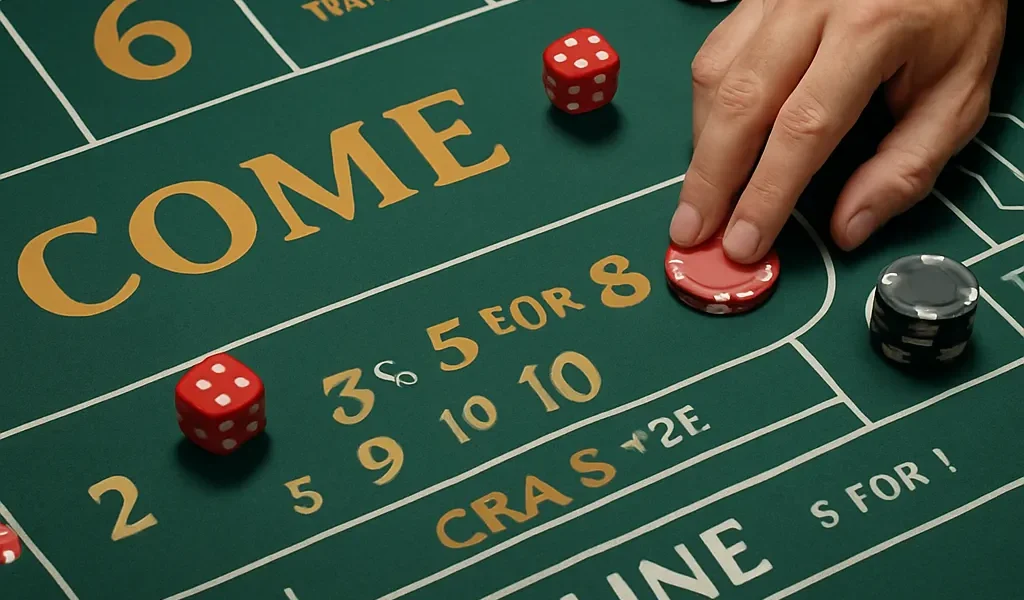So, you’ve walked past those loud tables in the casino where people are cheering, fists pumping, dice flying—and you’ve always wondered, “What’s all the fuss about craps?” Or maybe, like me the first time, you got sucked in by the energy, put down a chip, and had no clue what was happening. I get it. Casino craps can look wild and intimidating, but under the surface, it’s one of the most exciting and potentially rewarding games you’ll ever play. This guide is my attempt to answer the big question on every wannabe shooter’s mind—how do you actually win at craps? Let’s break down the madness, see what makes craps tick, and discover some strategies that might just tilt the odds in your favor (well, at least a smidge).
Introduction to Craps
Understanding the Basics of Craps
Okay, the basics. Craps is a dice game that’s older than your granddad’s fedora—seriously, it’s been around for centuries, in one form or another. The central thing you need to know is that you’re placing bets on the outcome of a roll, or series of rolls, of two dice. That’s it. Simple, right? Well, the catch is there are about a million types of bets you can make (okay, slight exaggeration), but some are way better than others. Everyone at the table is essentially rooting for or against the “shooter” (that’s the person tossing the dice). If you’ve never played, there’s a real thrill to hearing that clatter and watching Lady Luck work her mysterious magic. That unpredictability? That’s the hook.
When it comes to learning craps, I recommend not stressing over all the weird jargon at first (“yo” means eleven, “snake eyes” is two, and so on). Just soak up the basics: place your chips, roll the dice, and see what happens. Before you know it, you’ll start noticing patterns and picking up the lingo. The Pass Line, the Come bets, the excitement of making your ‘point’… it actually starts to make sense.
Why Craps is Popular at Casinos
If you’re asking why craps is always surrounded by crowds, well, here’s my honest answer: it’s fun, it’s fast, and there’s this buzzing team spirit you don’t really get anywhere else on the floor. I mean, blackjack is cool, poker can be intense—but craps? It’s electric. Everyone’s betting on the same roll, strangers high-fiving, and for those few minutes, it feels like you’re all in it together.
There’s also the draw of big payouts for small risks—if you bet smart. Most players get hooked by hearing success stories (I sure did, though the wins always seem bigger in retellings). Even better, casino craps generally features some of the best odds you’ll find in a gaming hall, especially compared to slot machines that eat your money like it’s popcorn. So, between the low house edge on certain bets (more on that later) and the contagious energy, you can see why craps keeps folks coming back for more.
Oh, and it’s impossible to ignore that rolling the dice yourself just feels awesome—if a little nerve-wracking. I’ll never forget the first time I got to shoot. My hands were shaking, but man, if you hit your number, you feel like a rockstar (at least for a minute, until the next shooter’s up).
The Craps Table Layout
Key Areas of the Craps Table
At first glance, the craps table layout is a serious sensory overload. There’s so much going on—numbers, boxes, names, flashing lights (if you’re in Vegas). But every area has a purpose, and if you take a second to learn where things are, it all clicks. The table is long and oval, like a big green racetrack with fancy road markings. The main real estate is split between the Pass Line, the Don’t Pass bar, boxes for various bets, and some spots for the more “exotic” wagers (if you’re feeling lucky or reckless, or both).
I remember my first time trying to place a “Come” bet—I couldn’t even find the spot without help from the dealer. Seriously, don’t be afraid to ask! Dealers are usually pretty friendly, especially if you’re new. There’s also the Field, the Place Bets, and a whole lot of numbers. Understanding where to put your chips can make a real difference—less confusion, fewer mistakes, and hey, you’ll look like you know what you’re doing. Which, let’s be honest, always feels good.
Common Bets and Their Payouts
Here’s where I wish someone had handed me a cheat sheet. There are tons of possible bets at the craps table, but honestly, a handful are worth your attention when you’re just starting out (or even when you know your way around). In the table below, you’ll find the most common bets—what you’re betting on, what they pay, and the sneaky house edge you should keep an eye on. Trust me, this can help keep your bankroll alive longer.
| Bet Name | What You Win On | Payout | House Edge (%) |
|---|---|---|---|
| Pass Line | Win on 7 or 11 (come out roll), point made | 1:1 | 1.41 |
| Don’t Pass | 2 or 3 (come out roll), 7 before point | 1:1 | 1.36 |
| Come | Win on 7 or 11 (first roll after placed), point made | 1:1 | 1.41 |
| Odds (behind Pass or Don’t Pass) | Backing up a Pass/Don’t Pass bet after point | 2:1, 3:2, 6:5 (varies based on point) | 0.00 |
| Place 6 or 8 | 6 or 8 before 7 | 7:6 | 1.52 |
| Field | 2, 3, 4, 9, 10, 11, 12 | 1:1 (2/12 pays 2:1) | 2.78 |
| Proposition Bets | Single-roll numbers (2, 3, 11, 12) | Varies | Up to 16.67 |
As you can see, there’s a huge difference in house edge between the “smart” bets (like the Pass Line or Odds) and the more “exciting” bets (looking at you, Yo-Eleven and those wild Hardways). My personal suggestion? Stick with low house edge until you’re more comfortable—and have a little scratch for the riskier stuff.
It still amazes me how many new players jump right to the exotic stuff, thinking they’re going to make a fortune on a single roll. Sorry, folks: that’s how the casino pays for the free drinks! Always sneak a look at these numbers before tossing your chips around.
Essential Craps Strategies
Beginner-Friendly Strategies
Alright, let’s get into the nitty-gritty: how do you actually win at craps, at least more often than you lose? For beginners, my number one tip is, don’t overthink it. Start simple. The Pass Line bet is both the classic and safest move to make. In fact, lots of seasoned shooters (that’s the dice-throwers) swear by staying there for their whole careers.
Once you’ve got the Pass Line down, go for the Odds Bet when the point is set. This is hands-down one of the best bets in the casino, because it has zero house edge. (Yes, really—casinos actually let you place a bet with no advantage for them, but only behind your original Pass/Don’t Pass bet. Sneaky, eh?)
The best thing I did as a beginner was ignore the side bets. I know, the “Any Craps” and “Hardways” sections are tempting, but they love rookie mistakes. If you stay disciplined, stick with Pass Line and Odds, you’re setting yourself up for the best shot possible—and you’ll look like you know what you’re doing, which is half the battle.
To get a feel for good starter bets, check out this quick list—the first thing I mentally run through before I ever put money on the line.
- Pass Line Bet: Place this as soon as you join the table. It’s easy and widely accepted as the beginner’s go-to move.
- Add the Odds Bet: After you have a point, place the odds bet behind your Pass Line chip. The higher the odds allowed by the table, the better.
- Avoid Side Bets: Just stay away from everything tempting in the center of the table. Field bets, proposition bets, “yo,” all of it.
Keep it simple, keep your cool, and don’t feel pressured to make lots of different bets just because other players are. You’re playing your game—nobody else’s.
Advanced Betting Techniques for Experienced Players
Once you’ve outgrown the basic bets (and maybe have a few decent wins under your belt), you might want to mix things up. This is where craps strategies start to get spicy—and hey, some work better than others. One popular approach among regulars is the “Iron Cross.” Sounds intimidating, but it’s just a way of covering as many numbers as possible, except you actually lose on 7. (Spoiler: the house always gets its edge somewhere.)
There’s also the Come Bet strategy, stacking Come bets with Odds on each until you’re riding several points at once. Risky? Yes. Fun? Heck yes. The Place Bets approach is another favorite: you put money on the 6 and 8 (since these roll a lot, statistically) and press your wins to try to build a tidy stack when the shooter gets hot.
Here’s a quick breakdown of some pro moves people swear by—and honestly, I’ve tried most of these. Sometimes they work; sometimes, well, you have to chalk it up to the gambling gods having other plans.
- Pressed Place Bets: Every time you win a Place Bet, increase the wager slowly. If the roll is hot, you can snowball some real earnings.
- Three-Point Molly: Take the Pass Line bet and then make a Come Bet; keep adding another Come Bet until you have three numbers “working,” each with Odds behind them.
- Lay Bet Backing: Bet on the Don’t Pass or Don’t Come lines, then lay Odds behind your bets—ideal for those who believe 7 is due soon.
- Regulated Regression: Start with high bets, then immediately pull them down once you’re up, protecting profits while staying in the action.
Remember, none of these craps strategies guarantee you’ll walk away a winner, but they do help you play smarter and maybe last longer at the table.
Also, don’t be afraid to adapt—you’ll notice some strategies just don’t fit certain tables’ moods or shooter streaks. I usually stick with what feels right after a few test runs with small bets.
Maximizing Your Odds with Proper Money Management
Let’s get real about the money side—because hey, nobody wants to be the sad sack who blows their entire night’s budget in ten minutes. Craps is a game of streaks, and sometimes things just don’t go your way. The rookies I see losing fast are almost always the ones who don’t have a plan for their chips.
The secret sauce? Having a budget, and then sticking to it like glue. I always bring a separate stash for gambling—never rent or food money. Set a win goal, set a loss limit, and have the courage to walk away when you hit either. Plus, decide on your typical bet size before you pick up the dice.
I also try not to “chase” losses—the urge is real, but it nearly always backfires. If you’re on a losing streak, take it as a sign to pause, not double down. There’s always another roll, another table, another day.
If you’re looking for tips, here’s a cheat sheet that’s saved my hide more than once:
- Only bet what you can afford to lose. Seriously.
- Decide on your basic unit (e.g., $5 or $10 chips) and stick to it for most of the session.
- Resist the urge to increase your bet dramatically after a loss.
- Set a win/loss limit and actually leave the table when you reach it. It’s harder than it sounds.
- Treat winnings as a bonus, not an excuse to play wilder bets.
A little discipline goes a long way at the craps table—and hey, it keeps the night fun even if you don’t hit that dream streak.
Common Mistakes and How to Avoid Them
Recognizing Bad Bets in Craps
It feels like every time I play, there’s some poor soul making bets that are absolute “sucker bets.” Trust me, I’ve been there. When you don’t know any better, you go for whatever looks flashy or has the biggest payout. But the ugly truth? Some bets at the craps table are infamous for their high house edge. These are the bets that make casinos rich—so if you want to improve your odds, avoid them like the plague.
Here’s where most folks trip up:
- Any 7: Pays 4:1, but the house edge is a nasty 16.67%.
- Hardways: Looks fun (rolling doubles for 4, 6, 8, 10), but the odds are heavily in the casino’s favor.
- Proposition Bets: All those bets in the center—snake eyes, yo, etc.—big payouts and even bigger risks.
- Big 6 or Big 8: Looks simple, but pays the same as a Place Bet with a much higher house edge. Why bother?
- Field Bets: Easy to understand, but not as generous as you’d hope over time.
My worst session ever came from chasing Hardways—hoping for a big win, but I just kept filling the casino’s coffers. Take it from me, learning to recognize (and avoid) these traps will seriously up your winning chances in craps.
Avoiding Common Pitfalls for Beginners
Craps is awesome, but being new means there are a few classic mistakes everyone makes at some point. Maybe you’ve even made some of these—no shame, we all start somewhere. Number one, don’t play hands you don’t understand. That’s how you end up betting on the wrong number or burning through your chips fast.
The classic errors? Playing above your budget, tossing chips on every bet because “why not,” thinking you’re due for a win after a losing streak (hot tip: you’re not—those dice are cold and uncaring). And don’t forget “table etiquette”—touching the dice when you shouldn’t, or grabbing chips out of turn, earns you dirty looks and possibly a talking-to from the stickman.
The number of times I’ve seen beginners jump up and down on the Place Bets, only to have no clue what’s happening when the roll doesn’t go their way—it’s more common than you think. Take your time. Watch a few rounds, ask the dealer questions, and always, always know how much you’re actually wagering each hand.
The good news? After a couple of games, most of these mistakes become ancient history. You’ll be helping the next newbie in no time.
FAQs on Craps Strategies
What Bets Should I Focus On?
This is the million-dollar question (sometimes literally). If you want to keep things as safe as possible, focus almost exclusively on the Pass Line, Don’t Pass, and then taking Odds bets when possible. These all offer the lowest house edge at the craps table, and, while you might not get rich overnight, you’ll keep your stack alive much longer.
If you’re feeling spicy, Place Bets on 6 or 8 are also reasonable, since those numbers turn up quite a lot in dice rolls. But honestly, nine times out of ten, my stack lasts longer when I just hang out on Pass/Don’t Pass and max out my Odds. The siren call of those big-payout center bets gets a lot of folks, but I try (mostly) to resist.
How Much Should I Bet?
Ah, bankroll management—the not-so-sexy secret to lasting in any casino game. My advice? Bet the table minimum while you’re getting the hang of things, then size up only when you’ve built up a few wins or feel truly comfortable. There’s no shame in being the “low roller.” Honestly, it’s the wise choice.
As a rule of thumb, never bet more than 5% of your total roll on a single bet (that way, you’re not wiped out after one bad toss). Set aside a separate budget for betting, and if you reach your loss limit, hit the breaks. Winning at craps is partly about survival—a longer session gives you way more chance to catch a good streak.
Can I Practice Craps for Free?
Absolutely—there are loads of online casinos that offer craps in demo mode, or handy phone apps that simulate dice rolls and bets. This is hands-down the best way to get a handle on the craps table layout and rules without risking any cash.
I spent a ton of time just playing around on free apps before ever stepping into a real casino. The bonus? You can try risky bets or new craps strategies guilt-free and figure out what works for you. So, yes: practice for free, build your confidence, and save your real money for when the odds might actually bend your way.
Conclusion and Final Thoughts
So, there you have it—my (hopefully helpful) take on winning at craps, straight from hours at the tables, a few painful losses, and even a couple of sweet victories. The heart of it, really, is this: keep your bets simple, your budget locked, and your vibe positive. The craps table is a blast, but only if you avoid the classic traps and play within your limits.
If I had to leave you with one piece of advice? Play for fun, enjoy the chaos, and don’t beat yourself up over losses. That’s the rollercoaster that is craps. And hey, if you hit that hot streak, ride it as far as it’ll take you—but remember, the dice always turn in the end.
Good luck, and may the next roll of the dice bring you the kind of memory you’ll be telling your friends about for years!








